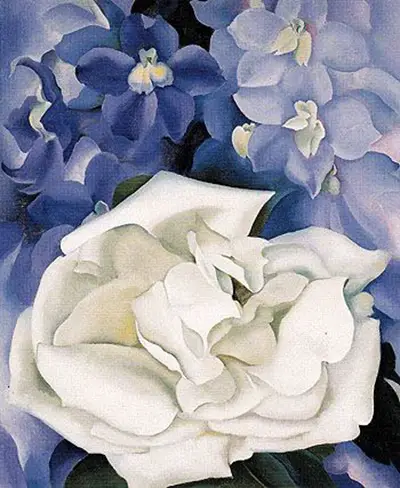This first version is less famous than White Rose with Larkspur II which can be found in the Museum of Fine Arts in Boston. Sadly, we do not know anything like as much about this first version, though a date of 1927 can be confidently attributed to it. Both place the white rose at the bottom of the canvas, dominating our attention, before further detail is added above. This perhaps reminds us of how O'Keeffe would sometimes place flowers in front of a landscape, as a means to effectively combine two of her key genres together - namely still life flowers and also landscape scenes of New Mexico. She was always looking to find ways of capturing nature in different ways, and that is how animal bones also appeared by the 1930s. In some cases she would use leaves as well, if they delivered an alternative tone of colour that she had not used before.
Petals overlap again and again, with shadows and a variety of shades of white helping to achieve an accurate depiction of the flower head, allowing it to lift from the surface of the canvas and create a more realistic, three dimensional image. She would always consider an artwork from the point of view of those looking at the painting for the first time, and so these were created in large forms and with enough detail to make us really feel a part of the scene. The larkspur here are, again, placed in the top half of the painting with some smaller elements of white amidst a predominantly dark tone of blue, as well as a fairly elaborate series of petals across that whole part of the composition.
"...Nobody sees a flower-really... I'll paint what I see-what the flower is to me but I'll paint it big and they will be surprised into taking time to look at it—I will make even busy New Yorkers take time to see what I see of flowers..."
At the time of writing, it was not possible to discover the location of the painting, though we do know that the next iteration in this series can be found at the Boston Museum of Fine Arts. Most of her work remains in the US, some in private collections and others available in major institutions spread right across the country. Followers of her career should head to the O'Keeffe Museum that provides a comprehensive study of her work and offers an interesting blend of paintings, covering the full breadth of her oeuvre. They also contribute to research into her career and have helped us to understand more about her life, documenting elements about her that we did not know about previously. To have a large museum dedicated to your art is rare, and underlines the qualities of her career and also the significance of it within the overall sphere of Modernism.
